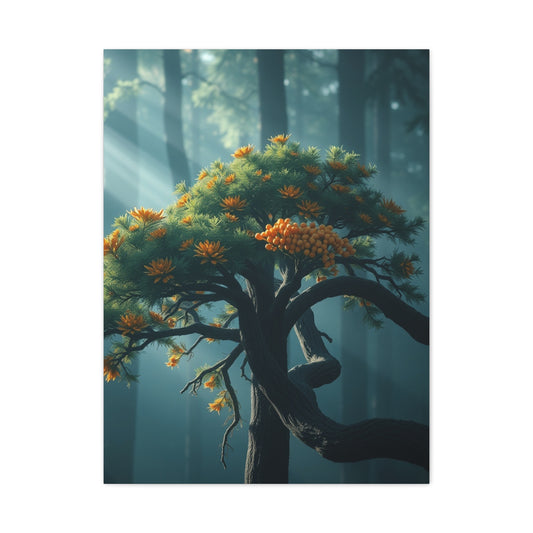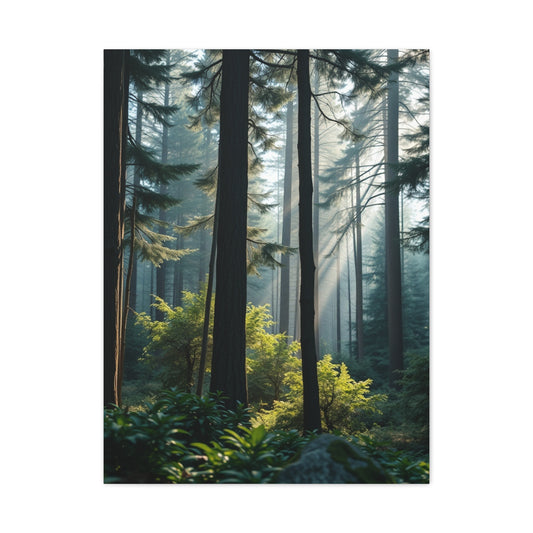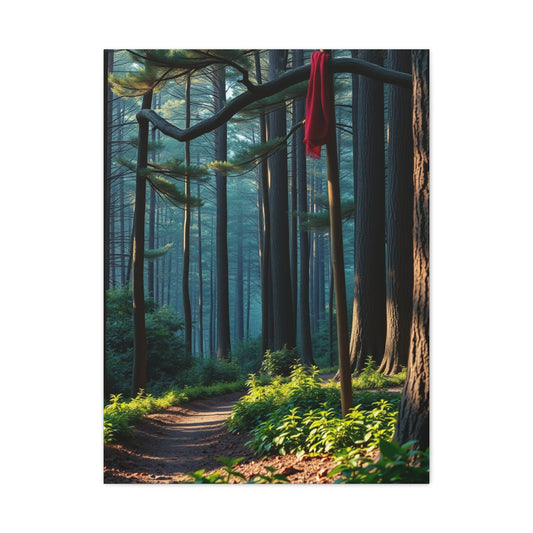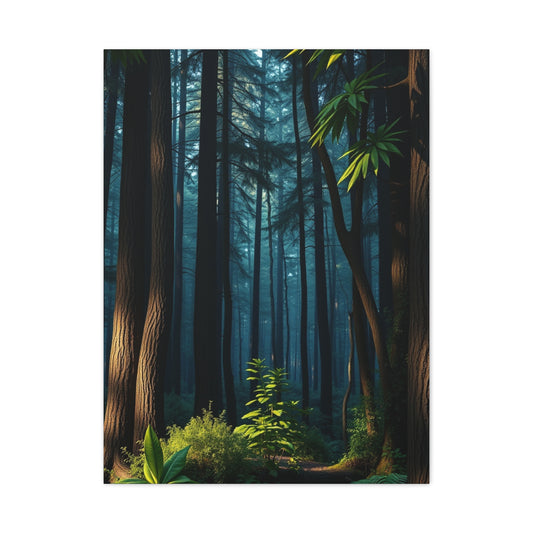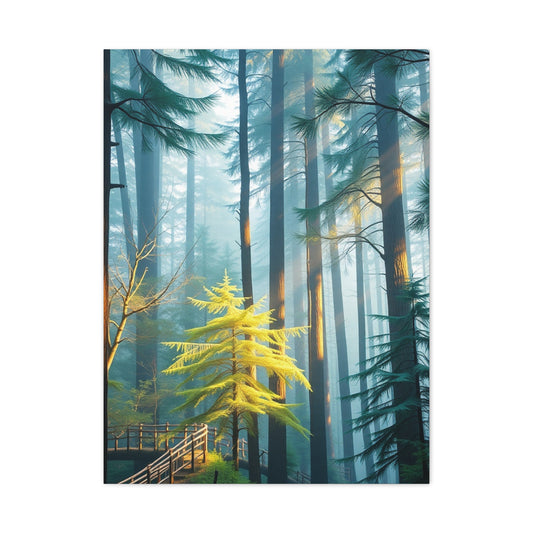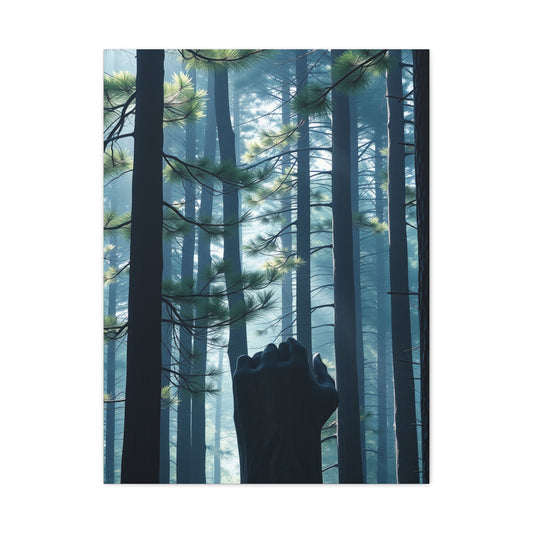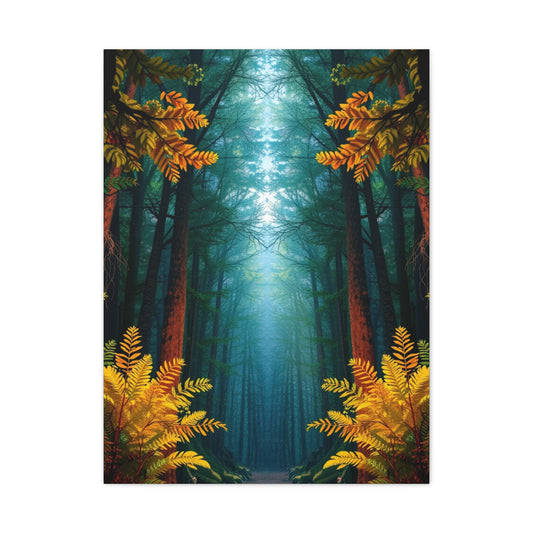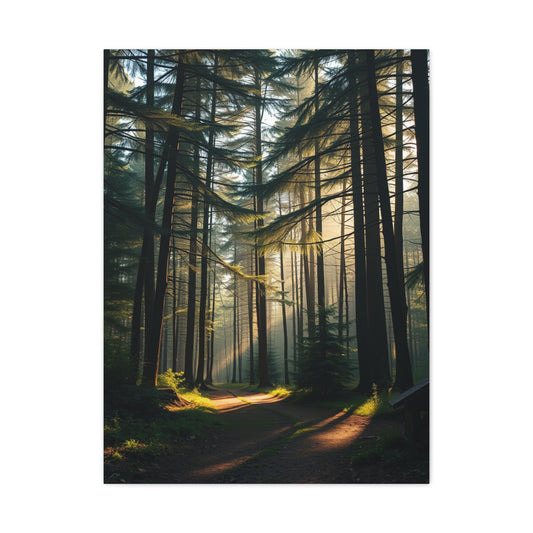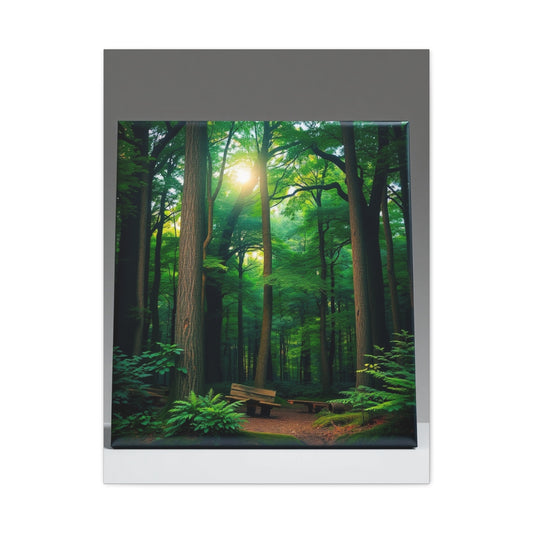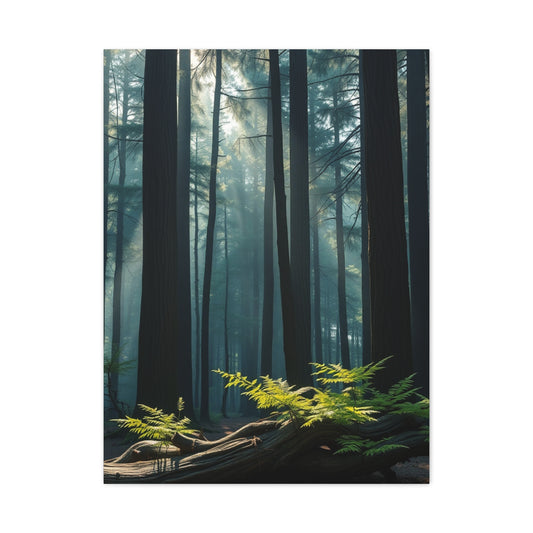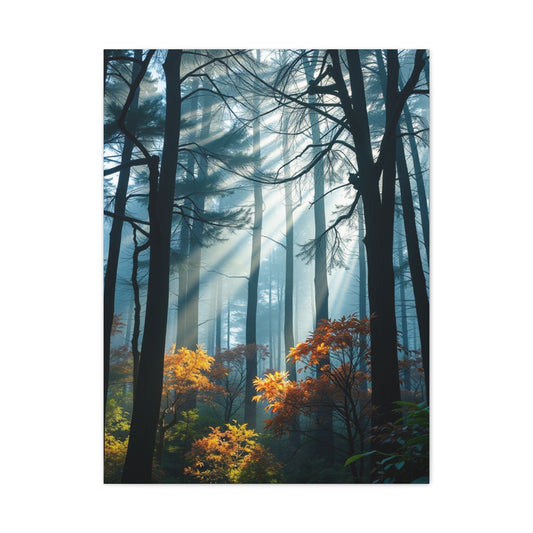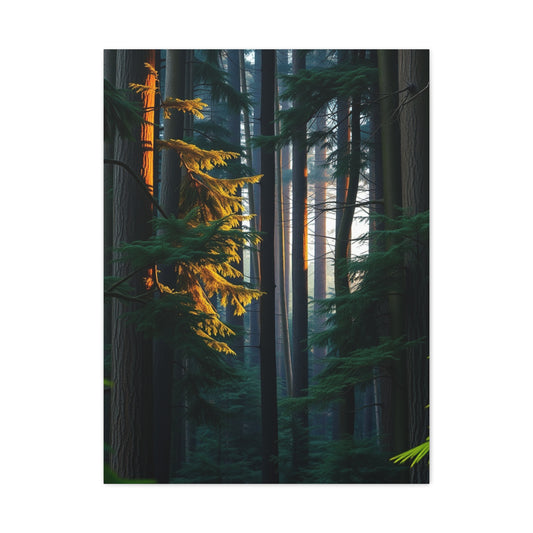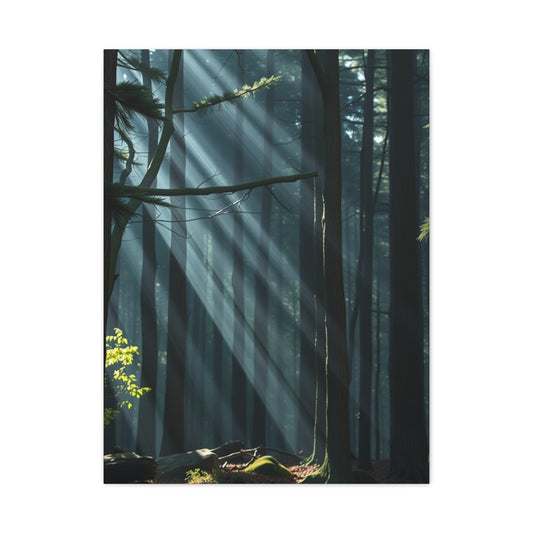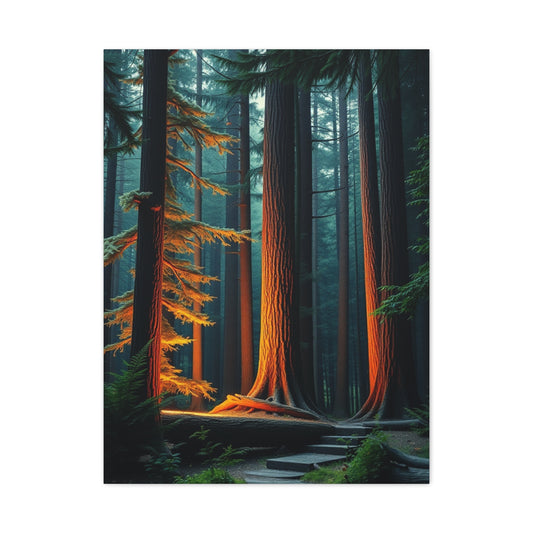How Forest Wall Art Brings Serenity and Calm to Your Home
The human mind has always been intimately connected with the natural world. From the dense woodlands that cradle life to the soft rustle of leaves in a tranquil forest, nature possesses an inherent ability to soothe, invigorate, and inspire. Yet, modern life, with its ceaseless barrage of notifications, crowded schedules, and urban congestion, has gradually distanced us from the restorative essence of the outdoors. In these circumstances, forest wall art emerges not merely as a decorative choice but as a conduit for reconnecting with a primordial calm, allowing the soul to breathe and the mind to rejuvenate.
Decorating your home with forest-inspired art can be likened to creating a private refuge, where each glance at the canvas invites serenity and reflection. The sight of towering trees, dappled sunlight filtering through verdant canopies, or a forest floor cloaked in delicate moss can evoke memories of tranquil walks, the gentle whisper of the wind, and the subtle chorus of woodland birds. These artworks become visual sanctuaries, transporting viewers from the frenetic pace of urban life to the contemplative quietude of nature.
Forest wall art encompasses a broad spectrum of aesthetics, from ethereal watercolor landscapes to high-definition photographic representations that capture minute details of bark texture, leaf veins, and the play of light and shadow. This diversity allows homeowners to select pieces that resonate with their personal sensibilities and the atmosphere they wish to cultivate in their living spaces. For instance, an expansive canvas of an autumn forest, with leaves in molten hues of amber and russet, can invoke warmth and comfort, while a mist-laden woodland scene might inspire reflection and calm.
The psychological benefits of forest imagery are well documented. Humans have evolved alongside natural environments, and our physiological and emotional systems respond positively to stimuli reminiscent of forests, meadows, and rivers. Viewing forest art can reduce stress, lower heart rates, and enhance mood by eliciting a sense of awe and wonder. The intricate patterns of branches, the gentle sway of foliage, and the harmonious palette of greens and browns provide a visual counterbalance to the artificial rigidity and monotony often encountered in modern interiors. Incorporating forest wall art into your home can thus become a subtle yet potent tool for mental well-being.
In addition to fostering calm, forest wall art can catalyze creativity and introspection. The mystique of ancient woods, the labyrinthine arrangement of trees, and the interplay of shadow and light can stimulate the imagination in ways few other stimuli can. Artists, writers, and thinkers have long drawn inspiration from woodland landscapes, using the forest as a metaphor for exploration, discovery, and the complexity of thought. By bringing forest imagery into your home, you invite an ever-present muse into your environment, one that encourages curiosity, innovation, and contemplation.
Creating a home environment enriched by forest art is also an exercise in mindfulness. In a world dominated by screens, notifications, and the constant pursuit of productivity, taking a moment to observe and absorb the details of a forest painting becomes an act of conscious presence. The mind slows, attention sharpens, and the simple act of gazing upon a serene woodland can become a meditative ritual. Over time, these moments accumulate, subtly reshaping your mental landscape and nurturing resilience, patience, and emotional equilibrium.
The placement of forest wall art within a home can significantly influence its impact. In living rooms or communal areas, large canvases featuring expansive forests can create a sense of openness and freedom, expanding the visual boundaries of the space. Bedrooms benefit from artwork depicting tranquil glades or softly lit forest paths, fostering relaxation and a restorative ambiance conducive to sleep. Even hallways and entryways, often overlooked in interior design, can serve as transitional zones where forest imagery prepares the mind for calm or reflection before engaging with the demands of daily life.
Beyond the immediate aesthetic and emotional effects, forest wall art also subtly reshapes the perception of the home itself. Interiors dominated by neutral or artificial hues can feel sterile or oppressive, whereas the introduction of natural imagery infuses warmth, vibrancy, and organic complexity. The nuanced textures and irregular forms found in forest landscapes break the monotony of linear architecture and manufactured materials, introducing a harmonious tension that enriches the sensory experience of the space. Each glance at the wall becomes a micro-journey into nature, a reminder of the vastness, complexity, and tranquility of the natural world.
The choice of medium further enhances the experiential quality of forest wall art. Canvas prints offer a tactile richness and depth that encourages close inspection, revealing subtle brushstrokes, gradations of color, and minute details that replicate the textures of bark, moss, or undergrowth. Photographic prints, particularly those with high-definition clarity, capture the ephemeral interplay of light, shadow, and atmospheric conditions, preserving fleeting moments of fog, dew, or sunbeams that can elevate the artwork from mere decoration to a window into another realm. Even mixed-media works that blend painting and photography can produce a layered, multidimensional effect that engages both the visual and emotional faculties of the observer.
Color, too, plays a pivotal role in the effect of forest art. Greens are inherently calming, associated with growth, renewal, and balance, while earth tones like browns and muted yellows evoke stability and grounding. Accent colors, such as the fiery reds and oranges of autumnal leaves, can invigorate the senses and inspire feelings of warmth and comfort. Thoughtful integration of these hues can harmonize with existing interior palettes or create intentional contrasts that emphasize both the natural beauty of the artwork and the architectural features of the space.
In contemporary urban homes, where exposure to nature is limited, forest wall art also serves an educational and philosophical function. It reminds inhabitants of the rhythms, cycles, and interconnections inherent in ecosystems, fostering environmental awareness and a sense of stewardship. Even in the absence of physical interaction with forests, daily encounters with their visual representations nurture an appreciation for biodiversity, seasonal change, and the intricate balance of life that persists beyond human habitation. This subtle but profound connection can influence lifestyle choices, promoting eco-conscious habits and a more harmonious relationship with the environment.
Moreover, forest wall art is inherently versatile, capable of complementing a variety of interior design styles. In minimalist spaces, a single forest canvas can serve as a focal point, introducing organic complexity without clutter. In eclectic or bohemian interiors, multiple pieces of woodland art can create a narrative or visual journey, inviting viewers to explore different moods, seasons, or perspectives. Even in highly modern or industrial spaces, the juxtaposition of rigid geometric forms with the fluid irregularity of natural imagery produces a dynamic tension that enriches the spatial experience.
The therapeutic potential of forest imagery also extends to social spaces. Homes designed with an awareness of communal well-being can benefit from shared encounters with nature through art. Living rooms adorned with expansive woodland scenes encourage conversation, reflection, and collective calm, while dining areas featuring sun-dappled forest glades can create an atmosphere of relaxed conviviality. The presence of nature-inspired visuals subtly moderates emotional intensity, encouraging patience, empathy, and attentiveness in interactions with family members, friends, or guests.
In addition, forest wall art can function as a tool for narrative expression. Each artwork tells a story: a solitary path leading into misty depths may suggest introspection or personal journey; a sunlit clearing surrounded by towering trees can symbolize hope, renewal, or the promise of discovery. By curating pieces that resonate with personal experiences, aspirations, or emotions, homeowners can craft a visual autobiography that unfolds across walls, offering both introspection and inspiration in daily life.
The sensory impact of forest art is not confined to the visual alone. Certain works incorporate subtle textures, metallic inks, or layered materials that invite tactile exploration, while others engage the imagination through evocative depictions of sound and scent—imagining the rustle of leaves, the whisper of wind, or the earthy aroma of damp soil. These multisensory dimensions enhance the immersive quality of the artwork, deepening the sense of presence within the depicted woodland.
Finally, forest wall art provides an enduring antidote to the pressures of modern life. In an era dominated by virtual interactions, artificial environments, and relentless activity, the ability to pause and experience a visual connection to the natural world becomes an act of self-preservation. Each piece of forest art is not merely an aesthetic choice but a quiet declaration of intent: to cultivate spaces of calm, reflection, and creative energy, to honor the rhythms of nature, and to nurture the mind, body, and spirit through the restorative power of visual immersion.
The Mental and Physical Benefits of Forest Wall Art
Nature has an extraordinary capacity to influence the human mind and body. Even brief interactions with verdant landscapes can evoke profound physiological and psychological responses. In contemporary life, where urban living, digital saturation, and relentless schedules dominate, these benefits are often inaccessible. Forest wall art provides an elegant solution by offering a consistent, immersive connection to the restorative qualities of woodland environments, all within the comfort of one’s home.
Viewing forest imagery triggers a cascade of positive effects on mental well-being. The intricate patterns of branches, the symmetry of leaves, and the dappled interplay of sunlight on forest floors engage the brain’s visual processing centers in ways that promote relaxation. Research in environmental psychology has consistently demonstrated that exposure to natural stimuli reduces cortisol levels, alleviates stress, and enhances emotional stability. Even a static depiction of a dense forest canopy can encourage the mind to slow down, fostering mindfulness and presence. The calming influence of such imagery is not merely anecdotal; it is rooted in evolutionary biology, as humans have developed over millennia in close association with natural landscapes.
Forest wall art is particularly effective in counteracting the sensory overload of modern urban environments. Cities are dominated by harsh lines, artificial lighting, and incessant noise, which can strain cognitive and emotional resources. By integrating forest art into living spaces, one introduces visual softness, organic complexity, and subtle chromatic variation that balance the rigidity of architectural structures. This visual reprieve allows the mind to reset, reducing mental fatigue and enhancing overall cognitive function. In essence, forest art functions as a sanctuary for the brain, providing restorative stimuli that nurture both focus and creativity.
The psychological effects of forest imagery extend beyond immediate relaxation. Viewing forests can cultivate emotional resilience and enhance mood regulation. The serene vistas depicted in forest wall art can elicit feelings of awe, wonder, and reverence, which are associated with increased life satisfaction and a heightened sense of connection to the broader world. These positive emotions are not transient; repeated exposure to natural imagery can gradually reinforce neural pathways that favor calmness, empathy, and patience. In this way, forest wall art becomes more than decoration—it is a subtle, ongoing intervention that nurtures mental health over time.
The interplay of light and shadow in forest imagery has additional therapeutic implications. Soft light filtering through leaves, the subtle glow of sunlight on moss, or misty atmospheres can influence circadian rhythms and perception of temporal flow. By providing visual cues reminiscent of natural daylight cycles, forest art can subtly support sleep patterns, enhance alertness during daytime hours, and contribute to a general sense of temporal harmony. The nuanced gradations of color found in forest scenes—from deep evergreen to warm amber—also influence emotional states, fostering feelings of comfort, optimism, and groundedness.
Moreover, forest wall art can act as a visual mindfulness anchor, facilitating meditative practices. Mindfulness involves focusing attention on the present moment with acceptance and curiosity, and forest imagery offers a compelling focal point for this practice. Observing the intricate details of tree bark, the interlacing of branches, or the texture of forest soil can draw attention away from rumination and anxious thought patterns. Over time, this visual mindfulness practice can enhance self-awareness, improve emotional regulation, and promote a sense of inner calm.
In addition to mental benefits, forest wall art can have subtle impacts on physical well-being. Studies have shown that exposure to natural scenes can reduce heart rate, lower blood pressure, and even improve immune function. The presence of forest imagery in a home environment creates an ongoing, low-level sensory experience akin to being in nature itself. For individuals who live in urban areas with limited access to parks or forests, this can help mitigate the physiological stressors associated with urban living. In this way, forest wall art functions as a preventive measure, supporting holistic health through continuous, passive exposure to natural stimuli.
Forest imagery also encourages movement and behavioral shifts that further enhance health. Subtle inspiration from a painting of a forest trail, a mossy glade, or a sun-dappled path can motivate individuals to spend more time outdoors, engage in walking or hiking, or cultivate indoor greenery. In this sense, forest wall art becomes a bridge between passive appreciation and active engagement with nature, creating a virtuous cycle in which visual exposure reinforces lifestyle choices that support well-being.
The therapeutic impact of forest wall art is amplified when it is thoughtfully integrated into the living environment. Placement, scale, and orientation all contribute to the effectiveness of visual therapy. For instance, a large canvas depicting a wide forest expanse can be positioned in a living room or study to create a sense of spatial openness, mitigating feelings of confinement in smaller urban dwellings. Smaller, intimate pieces in bedrooms or personal workspaces can provide moments of quiet reflection, offering a brief but impactful reprieve from daily stressors. The flexibility of forest art ensures that its benefits can be experienced throughout the home, in both communal and private spaces.
Forest wall art also supports emotional healing and psychological restoration in ways that go beyond everyday stress relief. For individuals experiencing anxiety, depression, or chronic stress, visual encounters with forest imagery can provide safe, non-intrusive exposure to natural environments. The consistent presence of calming scenes in personal spaces offers predictability and comfort, which are essential for emotional stability. Unlike outdoor experiences, which can be influenced by weather, accessibility, or safety concerns, wall art provides a reliable, controllable means of reconnecting with the natural world.
Furthermore, forest wall art can facilitate imaginative engagement, which in itself has therapeutic value. Forests are often associated with mystery, exploration, and discovery. When individuals immerse themselves in a woodland scene, even in their minds, they are engaging in cognitive exercises that stimulate problem-solving, narrative thinking, and creative visualization. This imaginative engagement can reduce rumination, improve mood, and enhance cognitive flexibility, demonstrating the multifaceted ways in which forest imagery supports mental health.
The choice of artistic medium also influences the depth of the therapeutic experience. High-definition photography can capture fleeting, intricate moments in the forest—morning mist, a shaft of sunlight piercing the canopy, or droplets of rain on leaves—evoking a sense of immediacy and presence. Paintings or mixed-media works, on the other hand, allow for artistic interpretation, abstraction, and emphasis on emotional resonance, which can deepen the viewer’s contemplative experience. Each medium offers unique pathways to engagement, catering to diverse aesthetic preferences and emotional needs.
Color psychology further enhances the health benefits of forest wall art. Shades of green are universally associated with growth, renewal, and tranquility, fostering relaxation and emotional balance. Earth tones—browns, muted yellows, and subtle oranges—instill grounding and stability, counteracting the disorienting effects of constant digital engagement. Accents of warmer colors, such as the deep reds and golds of autumn foliage, can evoke comfort and optimism, creating a nuanced emotional palette that nurtures well-being. By carefully selecting forest artwork with complementary colors, individuals can tailor the emotional atmosphere of their home to align with specific therapeutic goals.
In addition, forest wall art can enhance social and familial well-being. Communal spaces adorned with serene woodland imagery encourage shared moments of relaxation, reflection, and conversation. Whether placed in a living room, dining area, or shared workspace, forest art facilitates an environment conducive to empathy, attentiveness, and positive interpersonal dynamics. Visual encounters with calming natural scenes can subtly moderate emotional intensity, helping family members and guests navigate daily stresses with greater equanimity.
The inclusion of forest art in personal spaces can also foster environmental mindfulness. Regular exposure to visual representations of forests cultivates an appreciation for ecosystems, biodiversity, and the interconnectedness of life. Over time, this awareness can influence lifestyle choices, encouraging sustainable behaviors, conservation-minded decisions, and a deeper respect for the natural world. In this sense, forest wall art functions not only as a therapeutic medium but also as a vehicle for cultivating environmental consciousness and ethical engagement with the planet.
Finally, the long-term benefits of forest wall art are cumulative. Unlike fleeting outdoor experiences or sporadic meditation sessions, the presence of forest imagery within the home provides continuous exposure to restorative stimuli. Each glance at a painting, photograph, or mixed-media piece reinforces the calming, centering effects, gradually shaping mental habits, emotional resilience, and overall well-being. The forest becomes an ever-present companion, quietly supporting the rhythms of daily life, offering comfort, inspiration, and a profound sense of connection to the natural world.
How Forest Wall Art Stimulates Creativity and Imagination
The allure of forests has long captivated human imagination. Beyond their aesthetic charm, forests carry symbolic and psychological significance, evoking curiosity, wonder, and introspection. Integrating forest wall art into a home environment can serve as a catalyst for creativity, offering continuous inspiration for artistic, intellectual, and professional pursuits. By bringing these enigmatic landscapes indoors, individuals can harness the forest’s transformative energy, turning everyday living spaces into arenas for imaginative exploration and cognitive renewal.
The intricate patterns inherent in woodland environments are particularly potent in stimulating creativity. The interweaving of branches, the asymmetrical arrangement of foliage, and the irregular textures of bark present a visual complexity that encourages cognitive engagement. Unlike artificial or highly structured environments, forests resist predictability, prompting the brain to recognize patterns, anticipate forms, and make aesthetic judgments. When these patterns are captured in wall art, the observer benefits from this mental stimulation without leaving their home, activating neural pathways associated with problem-solving, innovation, and artistic expression.
Forest imagery also engages the imagination through narrative potential. Each woodland scene invites viewers to envision a story within its bounds: a hidden path winding through misty trees, a sunlit clearing that promises discovery, or a secluded grove teeming with unseen wildlife. These imagined narratives provide a form of mental escapism, allowing the mind to wander creatively while remaining grounded in the home environment. Over time, habitual engagement with such imagery can enhance divergent thinking—the ability to generate multiple solutions or perspectives—which is foundational to creativity and intellectual flexibility.
Moreover, forest wall art cultivates an atmosphere conducive to reflective thinking. In a modern context dominated by constant stimulation, finding moments of uninterrupted contemplation can be challenging. Forest imagery provides a visual anchor that encourages prolonged observation and meditation, fostering an environment where complex ideas can incubate and mature. The interplay of light and shadow in a forest scene, the subtle gradations of color, and the suggestion of movement through leaves and branches all contribute to a dynamic visual experience that stimulates introspection and innovative thought.
The impact of forest art on creativity extends to professional and academic environments as well. Studies in environmental psychology suggest that exposure to natural scenes enhances cognitive flexibility, improves focus, and increases problem-solving ability. By placing forest wall art in home offices, studios, or study areas, individuals can create a work environment that encourages idea generation, reduces mental fatigue, and promotes sustained attention. A painting of an ancient forest or a high-resolution photograph of a sun-dappled glade can become more than decoration; it becomes an inspirational tool, subtly shaping productivity and cognitive performance.
Color is another vector through which forest art stimulates the imagination. The myriad shades of green, punctuated by earthy browns and occasional vibrant florals, create a visual palette that nurtures both calm and creative energy. Greens are associated with growth and renewal, providing a mental environment that encourages experimentation and generative thinking. Warm hues in autumnal forests can evoke emotional warmth and imaginative resonance, while the cool tones of misty woodlands inspire reflection and nuanced ideation. By carefully selecting forest artwork with colors that align with intended cognitive or emotional goals, individuals can harness chromatic influence as a subtle enhancer of creativity.
Forest wall art also fosters multisensory imagination. While primarily visual, well-crafted pieces evoke auditory, tactile, and olfactory sensations: the imagined rustle of leaves in a gentle breeze, the soft give of moss underfoot, or the earthy scent of a damp forest floor. These sensory cues enrich cognitive engagement, allowing the viewer to mentally inhabit the forest space. Such immersive experiences can enhance creative visualization, supporting both artistic endeavors and problem-solving tasks that require mental simulation of complex environments.
The spatial arrangement of forest imagery further contributes to imaginative stimulation. Expansive landscapes painted or photographed on large canvases convey depth and perspective, offering a sense of openness and infinite possibility. In contrast, smaller, detailed works invite closer scrutiny, encouraging observation of microcosmic intricacies that might otherwise go unnoticed. By varying the scale and perspective of forest wall art, a home can become a gallery of visual experiences, each piece providing a distinct prompt for reflection, ideation, and inventive thought.
Forest art also intersects with the psychological concept of biophilia—the innate human affinity for the natural world. Biophilic engagement is known to reduce stress, enhance mood, and increase cognitive flexibility. By incorporating forest imagery into daily life, individuals can maintain a subtle yet constant connection with natural environments, promoting creative thought even in confined urban settings. This ongoing visual dialogue with nature fosters mental elasticity, allowing ideas to flow more freely and encouraging original perspectives.
In addition to fostering creativity on an individual level, forest wall art can inspire collaborative ideation. In communal living spaces, multiple viewers can interpret scenes differently, leading to shared discussion, storytelling, and co-creative exploration. For families, this can become a medium through which imaginative narratives are collectively generated. For work-from-home setups or shared studios, forest art can spark brainstorming sessions, providing a neutral, calming, yet stimulating visual backdrop that encourages group problem-solving and conceptual innovation.
Forest wall art also has a profound impact on emotional creativity—the capacity to channel feelings into imaginative or expressive endeavors. The emotive quality of woodland scenes can evoke nostalgia, serenity, awe, or introspection, each of which provides fertile ground for creative work. Artists, writers, and thinkers often draw inspiration from these emotional cues, transforming visceral responses into tangible output. A mist-shrouded forest might inspire a poetic reflection, while a sunlit canopy could catalyze a visual artwork or inventive project. The continual presence of such art in one’s environment ensures a persistent stimulus for creative exploration.
Furthermore, forest wall art invites philosophical contemplation, a key driver of higher-order creativity. The cyclical rhythms, interdependence of species, and seasonal transformations depicted in forests provoke reflections on temporality, growth, mortality, and resilience. Engaging with these themes encourages abstract thought, critical analysis, and conceptual experimentation, which are essential components of imaginative problem-solving and innovation. By integrating forest imagery into the home, residents create a space where both practical and abstract thinking can flourish in tandem.
Another dimension of forest wall art’s creative influence is its role in enhancing visual literacy. Observing the nuanced interplay of textures, light, shadow, and spatial depth in forest scenes sharpens perceptual skills, allowing viewers to recognize subtle distinctions in shape, color, and composition. This heightened visual awareness translates into improved capacity for visual communication, design, and artistic creation. In essence, the act of viewing forest art is not passive; it is an active training ground for perceptual acuity and imaginative thinking.
Forest art also nurtures symbolic and metaphorical thinking. Forests are rich in archetypes—paths suggest choices, dense groves evoke mystery, and clearings represent opportunity. Engaging with these symbols fosters interpretive flexibility, enhancing the ability to generate metaphorical connections and innovative analogies. Such cognitive skills are invaluable for writers, strategists, and problem-solvers, providing conceptual tools that extend beyond the immediate visual experience.
The meditative quality of forest wall art further supports creativity by creating mental space for incubation. The human brain often generates its most innovative ideas during periods of relaxed awareness rather than concentrated effort. By offering a calming visual anchor, forest imagery facilitates these incubation periods, allowing subconscious processing to unfold. A viewer might gaze at a forest path while sipping tea or pausing from work, and during these moments, insights, solutions, or creative sparks may emerge organically, nurtured by the subtle influence of the woodland scene.
Finally, forest wall art offers versatility in curating an inspirational environment. Large-scale canvases can dominate a room, creating an immersive sanctuary of creative potential. Smaller works can punctuate walls, offering recurring reminders of natural beauty and imaginative possibility. Mixed media or textured pieces provide additional sensory engagement, while monochromatic or abstract interpretations of forest landscapes encourage novel visual interpretations. Through careful selection and placement, homeowners can design an ecosystem of visual stimuli that continuously nurtures both cognitive and emotional creativity.
Forest Wall Art as a Medium for Personal Expression and Lifestyle
A home is far more than a collection of furniture and objects; it is an intimate reflection of its inhabitants’ inner worlds, values, and aspirations. Forest wall art, with its intricate textures, atmospheric depth, and emotive resonance, provides a compelling medium for personal expression, allowing residents to curate spaces that mirror their temperament, preferences, and relationship with the natural world. Beyond aesthetic appeal, forest imagery communicates identity, evokes emotional landscapes, and fosters a lifestyle imbued with mindfulness, creativity, and serenity.
Forest art enables subtle yet profound forms of self-expression. The choice of a dense, mist-covered woodland may convey introspection, a love for mystery, or a penchant for quiet contemplation. In contrast, an artwork depicting sunlit forest clearings and vibrant foliage might express optimism, openness, and a desire for connection with the external world. The nuances of light, color, and composition within each piece offer a vocabulary through which homeowners can articulate moods and sensibilities that might be difficult to convey through conventional décor alone.
The flexibility of forest wall art allows it to align with diverse interior styles while reflecting personal taste. Minimalist interiors benefit from a singular, striking woodland canvas that anchors the space with organic vitality, infusing it with warmth and depth. Eclectic or bohemian rooms can incorporate multiple forest pieces, creating a layered visual narrative that mirrors the complexity of the owner’s personality. Even contemporary or industrial spaces gain a touch of softness and dynamism when forest imagery disrupts linearity, inviting the inhabitants to inhabit a space that is simultaneously structured and organic, ordered yet alive.
Beyond aesthetic alignment, forest wall art supports emotional expression and therapeutic introspection. Individuals can choose artworks that resonate with specific memories, aspirations, or emotional states. A painting of a tree-lined path might evoke childhood walks through ancestral forests, while a misty, secluded grove could provide solace during periods of stress or introspection. The act of engaging with such art becomes a form of emotional dialogue, where the observer projects experiences, desires, and reflections onto the visual landscape, nurturing both understanding and self-compassion.
Forest wall art also plays a significant role in lifestyle integration. By consciously incorporating nature-inspired imagery into living spaces, residents cultivate environments that encourage mindfulness, intentional living, and engagement with the rhythms of the natural world. This integration extends beyond mere observation; it informs behavior, routines, and even choices related to wellness and leisure. Individuals may be inspired to spend more time outdoors, pursue gardening or ecological projects, or simply slow their pace within the home, allowing for reflection, creativity, and rejuvenation.
The placement of forest imagery within different areas of a home can reinforce specific lifestyle objectives. In bedrooms, serene glades or softly lit forest paths encourage relaxation, restful sleep, and reflective moments before rest. In living rooms, expansive woodland scenes provide focal points that invite shared observation, conversation, and collective engagement with natural beauty. Studies in environmental psychology suggest that visual exposure to forests can enhance social dynamics by moderating emotional intensity, encouraging patience, and fostering empathy, all of which support a lifestyle centered on harmonious interpersonal relationships.
Forest wall art also facilitates thematic cohesion within a home’s design narrative. Through deliberate selection of pieces that share motifs, color palettes, or stylistic elements, residents can craft a visual journey across rooms, echoing seasonal changes, cycles of growth, or temporal progression. A sequence of canvases that transitions from misty early mornings to sunlit afternoons and finally to twilight forest vistas can imbue the home with a sense of temporal flow and continuity, subtly reinforcing mindfulness and attentiveness to the passage of time.
Moreover, forest wall art can encourage conscious interactions with both the interior and exterior environment. Observing depictions of rich ecosystems may heighten awareness of biodiversity, seasonal cycles, and ecological interdependence. This visual engagement fosters a sense of stewardship, encouraging practices that support environmental sustainability, such as planting indoor greenery, participating in conservation initiatives, or making ecologically mindful lifestyle choices. In this way, forest art bridges the internal and external worlds, aligning personal spaces with values of environmental consciousness and intentional living.
Color, texture, and spatial composition in forest art contribute to lifestyle modulation by influencing mood, energy, and perceptual experience. The greens of dense foliage evoke calmness and balance, grounding occupants amid urban chaos. Earthy tones instill stability, warmth, and rootedness, while accents of amber, gold, or crimson can energize spaces, instigating inspiration and focus. Textural representation, such as the roughness of bark, the softness of moss, or the layered canopy of leaves, invites close observation, tactile imagination, and sensory engagement, all of which reinforce mindful living and presence.
Forest wall art also fosters personal rituals and contemplative practices. Individuals may designate specific spaces for reflection or meditation, using a woodland painting as a visual anchor for mindfulness, breathing exercises, or journaling. The artwork becomes a conduit for inner exploration, facilitating connection to personal values, aspirations, and emotional states. Over time, these rituals cultivate a lifestyle in which moments of pause, reflection, and creativity are seamlessly integrated into daily routines, enhancing overall well-being.
Additionally, forest imagery serves as a metaphorical mirror, reflecting the nuances of the human experience. Seasonal changes depicted in forest art—spring blossoms, summer verdure, autumnal decay, winter dormancy—can symbolize personal growth, transformation, and resilience. Paths winding through dense woods suggest journeys of exploration and decision-making, while clearings symbolize clarity, insight, or achievement. By engaging with these visual metaphors, residents gain new perspectives on personal challenges, ambitions, and transitions, transforming their living spaces into arenas for introspective and aspirational thought.
The capacity of forest wall art to support lifestyle aspirations extends to fostering creativity, learning, and intellectual curiosity. Observing complex woodland ecosystems stimulates pattern recognition, spatial awareness, and conceptual thinking. These cognitive exercises can enhance creative problem-solving, planning, and adaptive thinking, all of which are invaluable in both personal and professional spheres. Forest art thus serves as an ever-present intellectual stimulus, reinforcing habits of observation, analysis, and imaginative exploration.
Forest wall art also encourages a slower, more deliberate engagement with one’s surroundings, countering the fast-paced, distraction-driven tendencies of modern life. By drawing attention to details—subtle gradients of light, the interlacing of branches, or the microcosms of flora and fauna—viewers cultivate patience, attentiveness, and appreciation for subtlety. This attentional recalibration carries over into other aspects of life, fostering a lifestyle characterized by mindfulness, intentionality, and deeper connection to both the physical and emotional environment.
The symbolic resonance of forest imagery further enriches personal expression. Trees can represent strength, endurance, and growth; forests can symbolize interconnectedness, mystery, or exploration. By selecting artwork that aligns with personal symbolism, residents communicate values and aspirations without words. Each piece becomes a narrative device, telling stories of resilience, curiosity, and harmony with the natural world. Over time, these visual narratives reinforce identity and self-conception, creating a home environment that is both expressive and affirming.
Forest wall art also encourages cultural and artistic exploration. Many woodland artworks incorporate regional flora, traditional artistic techniques, or stylistic interpretations unique to particular geographies. Engaging with such pieces exposes viewers to new cultural aesthetics and artistic philosophies, expanding horizons and enriching the intellectual and emotional life of the home. This cross-pollination of art and culture aligns with lifestyles that value curiosity, lifelong learning, and aesthetic discernment.
Infusing Vibrancy and Aesthetic Harmony Through Forest Wall Art
The natural world is a repository of color, texture, and dynamic energy, qualities that can profoundly transform the ambiance of a home when captured in forest wall art. Beyond its psychological and creative benefits, forest imagery serves as a potent vehicle for infusing vibrancy, harmony, and depth into interior spaces. By thoughtfully incorporating woodland scenes into walls, individuals can cultivate environments that are visually stimulating, emotionally resonant, and aesthetically cohesive, bridging the gap between the serenity of nature and the demands of contemporary living.
One of the most immediate effects of forest wall art is its ability to introduce color into a home environment in a manner that feels organic and multidimensional. The deep greens of pine and deciduous leaves evoke balance and renewal, while warm amber, ochre, and russet tones of autumnal foliage provide emotional warmth and grounding. Splashes of floral or fruit colors—scarlet berries, lilac blossoms, or golden sunbeams—add accentual vitality without overwhelming the visual equilibrium of a room. This chromatic richness enhances spatial perception, drawing attention to details, creating focal points, and elevating the overall aesthetic experience of a home.
Beyond color, forest imagery introduces textural complexity and visual rhythm that contrast with the often uniform or rigid surfaces of contemporary interiors. The interplay of bark, moss, leaves, and undergrowth in paintings or photographic prints creates layers of depth and nuance, inviting prolonged observation and engagement. These tactile illusions stimulate perception, subtly enriching the sensory environment and transforming flat, static walls into portals of immersive visual experience. In doing so, forest wall art fosters an atmosphere where inhabitants feel simultaneously grounded and invigorated, enveloped in a space that is at once calm and dynamic.
The vibrancy of forest imagery also has psychological implications. The human eye and mind are inherently drawn to the irregular patterns, organic lines, and harmonious contrasts found in natural landscapes. These elements reduce mental fatigue, enhance focus, and contribute to an overall sense of well-being. Forest wall art, by mirroring the intricacies of natural ecosystems, provides a continuous source of sensory and cognitive stimulation, allowing occupants to experience restorative effects similar to those achieved through actual interaction with outdoor environments. Even in confined or urban settings, the visual dynamism of woodland scenes introduces rhythm and vitality into daily life.
Scale and placement of forest artwork further amplify its transformative potential. Large, panoramic canvases depicting sprawling forest landscapes can create the illusion of expanded space, making rooms feel more open, airy, and inviting. These expansive works serve as visual anchors, guiding the gaze and establishing a focal point that harmonizes with furniture arrangement, lighting, and architectural elements. Conversely, smaller, detailed pieces can be grouped to create narrative clusters or accentuate particular areas, adding intimacy and encouraging close visual exploration. The careful calibration of scale and placement ensures that forest imagery enhances both aesthetic coherence and the experiential quality of the space.
In addition to visual vibrancy, forest wall art contributes to thematic and emotional continuity across a home. By selecting pieces that evoke different times of day, seasons, or moods, homeowners can create a subtle temporal and emotional narrative. For instance, a sequence of forest scenes transitioning from dewy morning glades to golden sunset can imbue a sense of cyclical harmony, reminding inhabitants of the natural rhythms of life and the progression of time. Such visual storytelling elevates interior design beyond static decoration, transforming walls into experiential landscapes that engage both mind and spirit.
The integration of forest imagery also supports color and material harmonization within interior spaces. Greens, browns, and earth tones complement a wide array of furniture finishes, upholstery, and flooring materials, creating cohesion without rigid uniformity. Accents drawn from the artwork—such as the burnt orange of leaves or the soft violet of twilight—can be echoed in textiles, cushions, or decorative accessories, producing a carefully orchestrated interplay between art and environment. Through this process, forest wall art functions as both a visual anchor and a guide for cohesive interior styling, uniting disparate elements under a unifying natural theme.
Beyond aesthetics, forest wall art contributes to emotional vibrancy. The immersive quality of woodland scenes invites contemplation, fosters curiosity, and nurtures imagination. Observers may feel a sense of adventure as their eyes trace winding paths, a surge of hope as sunlight pierces the canopy, or a quiet contentment as mist envelops moss-covered ground. These emotional responses, continuously reinforced by daily visual engagement, transform living spaces into environments of emotional richness, where inhabitants can experience both tranquility and invigorated awareness simultaneously.
Forest wall art also has a profound effect on lighting perception. The depiction of sunlight filtering through branches or illuminating forest floors can manipulate the perceived luminosity of a room, creating the impression of natural light even in spaces with limited exposure. Reflections, highlights, and shadow play in artwork can interact with artificial lighting to enhance spatial depth and dynamic visual interest, fostering an atmosphere that feels alive and responsive. Such visual strategies demonstrate the capacity of forest imagery to modulate not only aesthetic but also experiential qualities of a home.
The integration of forest art encourages holistic interior coherence by bridging functionality and aesthetics. Rooms enriched with woodland imagery tend to invite lingering, reflection, and engagement with the environment. Living areas become welcoming hubs for conversation and relaxation, while private spaces—such as bedrooms or studies—transform into sanctuaries for contemplation, reading, or creative pursuits. The presence of forest imagery naturally dictates a rhythm of interaction with the space, where visual engagement becomes a medium for emotional restoration and aesthetic pleasure.
Forest wall art also fosters an interplay between permanence and temporality. Seasonal depictions, shifting light, and subtle atmospheric effects captured in paintings or photographs evoke continuous change and movement, echoing the dynamic nature of life itself. This visual narrative reinforces mindfulness, encouraging observers to appreciate moments of beauty and impermanence, cultivating a lifestyle oriented toward presence and conscious engagement with the surrounding world. By reflecting natural cycles within interior spaces, forest art deepens both aesthetic appreciation and emotional awareness.
Moreover, forest imagery promotes a dialogue between indoor and outdoor environments. Even in urban or interior-dominated settings, the presence of woodland scenes sustains a connection to external ecosystems, subtly encouraging engagement with real-world natural environments. Individuals may be inspired to explore local parks, create indoor plant sanctuaries, or adopt environmentally conscious habits. The vibrancy and realism of forest wall art thus extend beyond visual appeal, shaping behaviors and lifestyle choices that resonate with broader ecological awareness.
Texture and medium further enhance the aesthetic and sensory impact of forest wall art. Canvas prints, for example, provide tactile depth, emphasizing brushstrokes and the layered complexity of natural forms. Photographic prints capture precise details of foliage, bark, and light, rendering fleeting moments with clarity and immediacy. Mixed-media pieces combine dimensionality, texture, and color manipulation to produce immersive experiences that engage multiple senses. These material choices enrich the visual and emotional resonance of forest art, making each piece an active participant in shaping the home’s atmosphere.
The vibrancy of forest art also encourages psychological rejuvenation. Exposure to visually stimulating natural scenes enhances mood, reduces mental fatigue, and fosters a sense of vitality. Forest imagery introduces both novelty and continuity, balancing the need for visual interest with the stabilizing effects of familiar natural forms. This balance ensures that living spaces are not only beautiful but also psychologically supportive, nurturing both emotional equilibrium and perceptual engagement over time.
In communal areas, forest wall art enhances social and relational dynamics. Its calming influence promotes patience, attentiveness, and empathy, subtly shaping interactions among family members, guests, or colleagues. The aesthetic vibrancy of the artwork also invites shared observation, storytelling, and imaginative exploration, fostering connection and dialogue. As such, forest imagery enriches both private and collective experiences, reinforcing its role as a versatile and impactful element of home design.
Furthermore, forest wall art provides a timeless aesthetic that transcends trends. Unlike ephemeral décor fads, woodland imagery retains its appeal by tapping into the enduring human affinity for nature. Trees, foliage, sunlight, and forest paths offer an ever-relevant visual language that harmonizes with diverse design schemes, from minimalism to eclectic interiors. This longevity ensures that forest artwork remains a cornerstone of aesthetic vibrancy, continuing to enhance living spaces for years without necessitating frequent updates or replacements.
Finally, the integration of forest wall art transforms a house into a holistic environment where color, texture, emotion, and cognition intersect. Walls cease to be static dividers and instead become living narratives of nature’s vibrancy, aesthetic complexity, and restorative energy. By engaging with these visual landscapes daily, inhabitants experience both sensory delight and emotional enrichment, cultivating spaces that are dynamic, inspiring, and harmoniously aligned with the rhythms of the natural world. Forest wall art, in essence, elevates interiors from functional habitation to immersive environments that nourish mind, body, and spirit.
Conclusion
In essence, forest wall art transcends conventional decoration, offering a multidimensional impact on the home and its inhabitants. By bringing the tranquility, complexity, and vibrancy of woodland landscapes indoors, it fosters mental clarity, emotional resilience, and creative inspiration. Each piece serves as a visual sanctuary, encouraging mindfulness, reflection, and imaginative exploration, while subtly connecting occupants to the rhythms of the natural world. Beyond psychological and aesthetic benefits, forest imagery allows personal expression, aligning interior spaces with values, memories, and lifestyle aspirations. Its dynamic color palettes, intricate textures, and immersive depth infuse vibrancy and harmony, transforming living environments into spaces that nurture both mind and spirit. Ultimately, forest wall art provides an enduring bridge between nature and daily life, enabling homes to become sanctuaries of calm, creativity, and beauty, where inhabitants can recharge, reflect, and thrive amid the restorative presence of nature.

